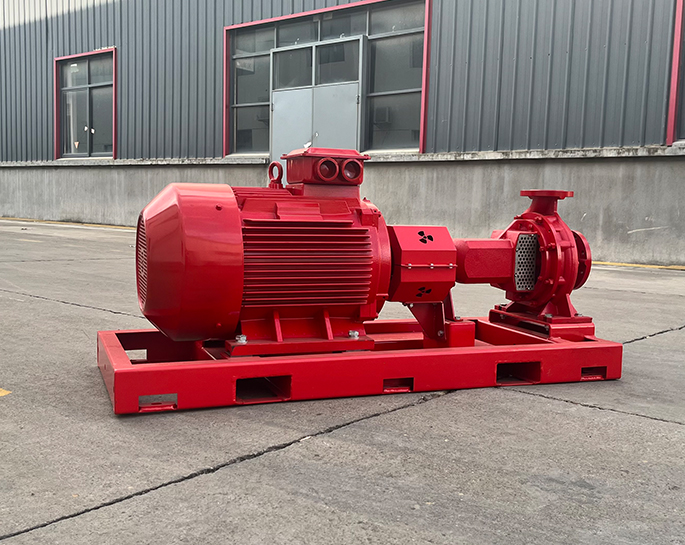What are the considerations for selecting the appropriate control logic and sequencing for electric fire pump systems?
Apr 08, 2024
Share:
Selecting the appropriate control logic and sequencing for electric fire pump systems is crucial to ensure reliable operation and effective response during fire emergencies. Here are some key considerations:
1. **System Design and Configuration**: Understand the specific design and configuration of the electric fire pump system, including the number of pumps, their capacity, pressure ratings, and any integrated controls or backup systems. The control logic should be tailored to the system's layout and requirements.
2. **Regulatory Compliance**: Ensure compliance with relevant codes and standards such as NFPA 20 and NFPA 25, which provide guidelines for fire pump control and sequencing. Adherence to these standards helps ensure the system operates safely and effectively.
3. **Emergency Response Requirements**: Consider the expected performance criteria and response times for the fire pump system during fire emergencies. The control logic should facilitate rapid activation and operation of the pumps to meet the required flow and pressure demands for firefighting.
4. **Redundancy and Reliability**: Incorporate redundancy and fail-safe mechanisms into the control logic to minimize the risk of system failure. This may include redundant controllers, sensors, power supplies, and communication pathways to ensure continuous operation even in the event of component failures.
5. **Sequencing and Interlocks**: Develop a logical sequence of operations for starting, stopping, and transitioning between pumps based on system demand and conditions. Implement interlocks and safeguards to prevent unsafe operating conditions such as pump overload, cavitation, or reverse flow.
6. **Monitoring and Diagnostics**: Integrate monitoring and diagnostic capabilities into the control system to detect faults, malfunctions, or deviations from normal operation. Real-time feedback and alerts enable operators to identify and address issues promptly, minimizing downtime and ensuring system reliability.
7. **Integration with Fire Detection and Alarm Systems**: Coordinate the control logic with fire detection and alarm systems to automatically activate the fire pump in response to detected fire events. This integration ensures timely response and coordination with other fire protection measures.
8. **Remote Monitoring and Control**: Consider implementing remote monitoring and control capabilities to allow for centralized supervision and control of the fire pump system. Remote access enables operators to monitor system status, adjust settings, and initiate emergency responses from a remote location if necessary.
9. **Training and Familiarization**: Ensure that personnel responsible for operating and maintaining the fire pump system receive adequate training and familiarization with the control logic and sequencing. Training programs should cover normal operation, emergency procedures, troubleshooting, and system maintenance.
10. **Documentation and Testing**: Document the control logic and sequencing details, including diagrams, flowcharts, and operating procedures. Conduct regular testing and validation of the control system to verify its functionality and performance under various operating conditions.
By considering these factors, stakeholders can select and implement appropriate control logic and sequencing for electric fire pump systems to ensure reliable and effective fire protection capabilities.

1. **System Design and Configuration**: Understand the specific design and configuration of the electric fire pump system, including the number of pumps, their capacity, pressure ratings, and any integrated controls or backup systems. The control logic should be tailored to the system's layout and requirements.
2. **Regulatory Compliance**: Ensure compliance with relevant codes and standards such as NFPA 20 and NFPA 25, which provide guidelines for fire pump control and sequencing. Adherence to these standards helps ensure the system operates safely and effectively.
3. **Emergency Response Requirements**: Consider the expected performance criteria and response times for the fire pump system during fire emergencies. The control logic should facilitate rapid activation and operation of the pumps to meet the required flow and pressure demands for firefighting.
4. **Redundancy and Reliability**: Incorporate redundancy and fail-safe mechanisms into the control logic to minimize the risk of system failure. This may include redundant controllers, sensors, power supplies, and communication pathways to ensure continuous operation even in the event of component failures.
5. **Sequencing and Interlocks**: Develop a logical sequence of operations for starting, stopping, and transitioning between pumps based on system demand and conditions. Implement interlocks and safeguards to prevent unsafe operating conditions such as pump overload, cavitation, or reverse flow.
6. **Monitoring and Diagnostics**: Integrate monitoring and diagnostic capabilities into the control system to detect faults, malfunctions, or deviations from normal operation. Real-time feedback and alerts enable operators to identify and address issues promptly, minimizing downtime and ensuring system reliability.
7. **Integration with Fire Detection and Alarm Systems**: Coordinate the control logic with fire detection and alarm systems to automatically activate the fire pump in response to detected fire events. This integration ensures timely response and coordination with other fire protection measures.
8. **Remote Monitoring and Control**: Consider implementing remote monitoring and control capabilities to allow for centralized supervision and control of the fire pump system. Remote access enables operators to monitor system status, adjust settings, and initiate emergency responses from a remote location if necessary.
9. **Training and Familiarization**: Ensure that personnel responsible for operating and maintaining the fire pump system receive adequate training and familiarization with the control logic and sequencing. Training programs should cover normal operation, emergency procedures, troubleshooting, and system maintenance.
10. **Documentation and Testing**: Document the control logic and sequencing details, including diagrams, flowcharts, and operating procedures. Conduct regular testing and validation of the control system to verify its functionality and performance under various operating conditions.
By considering these factors, stakeholders can select and implement appropriate control logic and sequencing for electric fire pump systems to ensure reliable and effective fire protection capabilities.







